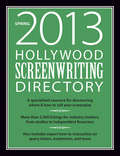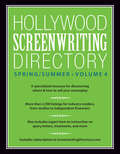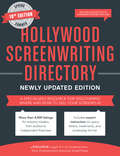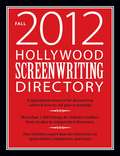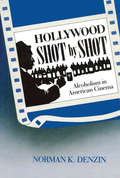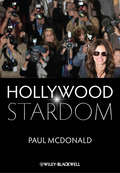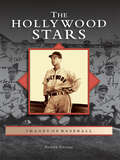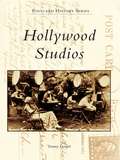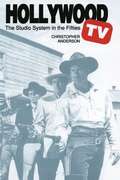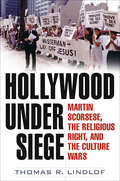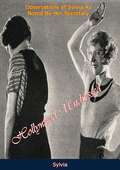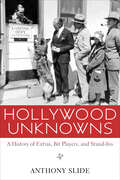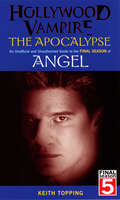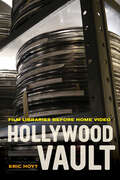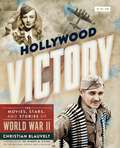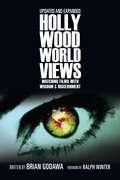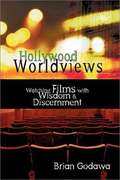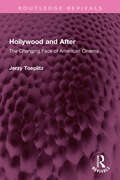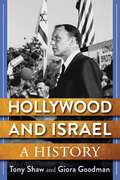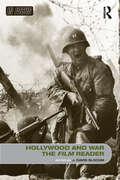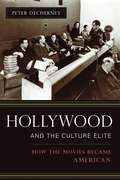- Table View
- List View
Hollywood Screenwriting Directory Spring 2013
by Jesse DoumaScreenwriting market intel you won't find anywhere else! Mailing out submissions based on some contact information you found on the Internet isn't going to get your script sold. What's truly valuable to an aspiring screenwriter is the kind of specific details you can only get through years of Industry experience. That's why The Writers Store compiled the Hollywood Screenwriting Directory, the product of more than three decades working directly with the people behind the world's favorite films. This targeted reference book features: Verified contact information for Hollywood buyers, including phone numbers, and street and email addresses. Crucial details like whether they accept unsolicited material and how they prefer to receive submissions. A guide to proper script format and advice on packaging your submission. Step-by-step instructions for writing professional query letters, treatments and tag lines. Plus, you'll find samples throughout, illustrated with tips and pointers to help you create a quality submission. With the Hollywood Screenwriting Directory by your side, you'll have a reliable resource that significantly ups your chances of script-selling success!
Hollywood Screenwriting Directory Spring/Summer Volume 4
by Writer's Store EditorsThe Hollywood Screenwriting Directory is a specialized resource for discovering where and how to sell your screenplay. It contains over 2,500 listings for Industry insiders such as studios, production companies, and independent financiers - plus, pointers to help you create a quality screenplay submission. The Hollywood Screenwriting Directory includes a free subscription to ScreenwritingDirectory.com, where screenwriters can access updated listings and market their projects to Industry Professionals.
Hollywood Screenwriting Directory Spring/Summer Volume 4: A Specialized Resource for Discovering Where & How to Sell Your Screenplay
by Writer's Store EditorsThe Hollywood Screenwriting Directory is a specialized resource for discovering where and how to sell your screenplay. It contains over 2,500 listings for Industry insiders such as studios, production companies, and independent financiers - plus, pointers to help you create a quality screenplay submission. The Hollywood Screenwriting Directory includes a free subscription to ScreenwritingDirectory.com, where screenwriters can access updated listings and market their projects to Industry Professionals.
Hollywood Screenwriting Directory Spring/Summer: A Specialized Resource for Discovering Where & How to Sell Your Screenplay
by Jesse Douma Dinah PerezReady to submit your screenplay but not sure about the logistics? With over 4,000 listings for Industry insiders such as studios, production companies, and independent financiers, this handy directory gives you the scoop on query letters, treatments and much more. Plus, the Legal 411 for Screenwriters section by entertainment attorney Dinah Perez is well worth the cost of the book. Get a head start with:Correct addresses and info for buyers (more than 4,000 listings!)The top ways to write and format loglines, treatments and query lettersInside screenwriting intelThe legalities of screenwriting and more from Dinah Perez!Up-to-Date It's true that contact information in Hollywood can change in the blink of an eye. You'll benefit from the updates to more than 50 percent of last year's listings. Also new are Facebook profiles, email addresses and more.What Matters to You Tons of information is included because so many things go into a successful submission. Browse information such as:Verified contact details, so you can email, phone or stop by in personPackaging your submission for best resultsScript formatWho receives unsolicited workThe legalities that go into each stage of the screenwriting and production processHow each financier, production company or studio wants submissions
Hollywood Screenwriting Directory: A Specialized Resource for Discovering Where & How to Sell Your Screenplay
by The Writers Storedirectory
Hollywood Shot by Shot: Alcoholism in American Cinema (Communication And Social Order Ser.)
by Norman K. DenzinTo what extent have Hollywood feature films shaped the meanings that Americans attach to alcoholics, their families, and the alcoholic condition? To what extent has the mass culture of the movie industry itself been conceptually shaped by a broad, external societal discourse? Norman Denzin brings to his life-long study of alcoholism a searching interest in how cultural texts signify and lend themselves to interpretation within a social nexus. Both historical and diachronic in his approach, Denzin identifies five periods in the alcoholism films made between 1932 and the end of the 1980s, and offers a detailed critical reading of thirty-seven films produced during these six decades.
Hollywood Sound Design and Moviesound Newsletter: A Case Study of the End of the Analog Age
by David StoneAs film students and younger fans experience "Big Hollywood Sound" in Imax presentations and digital theaters, many are also discovering action and adventure movies made well before they were born. There is a legacy to be enjoyed in the sound of these films: Blockbuster movies of the ‘80’s, and ‘90’s are notable for the extraordinarily dramatic impact of their sound mixing, and the way in which it could immerse audiences in a surrounding space. During this period, a small group of sound professionals in Hollywood wrote and published a critical journal about the craftsmanship, new technology, and changing aesthetics that excited conversation in their community. Their work has been edited and compiled here for the first time. David Stone is a sound editor, a veteran of roughly 100 Hollywood feature films, such as Gremlins, Top Gun, Die Hard, Speed, and Ocean’s 11. He was a Supervising Sound Editor for projects as varied as Predator, Edward Scissorhands, Beauty and the Beast, Batman Returns, City Slickers 2, and Dolores Claiborne. He has collected Golden Reel awards for Best Sound Editing five times, and won the 1992 Academy Award® for best Sound Effects Editing, for his supervising work on Bram Stoker’s Dracula. In 2015, he received a Lifetime Achievement Award from the San Luis Obispo Jewish Film Festival in California. Stone is now a Professor and former Chair of Sound Design at Savannah College of Art and Design. Between 1989 and 1994, he was the editor of Moviesound Newsletter, which was published by Vanessa Ament. Dr. Vanessa Theme Ament is the author of The Foley Grail, and a contributor to Sound: Dialogue, Music, and Effects (the Silver Screen Series). She is on the steering committee for Cinesonika, an international film festival and conference. A veteran Foley artist, sound editor, and voice actor from Los Angeles, she also writes and sings jazz, and is a member of the American Federation of Musicians, SAG-AFTRA, Actors Equity, and the Editors Guild. She worked on Die Hard, sex, lies, and videotape, Platoon, Predator, Edward Scissorhands, Beauty and the Beast, Noises Off, and A Goofy Movie, and many other films. Dr. Ament received her Ph.D. in Communication, in the area of Moving Image Studies, from Georgia State University in Atlanta, and is presently the Edmund F. and Virginia B. Ball Endowed Chair Professor of Telecommunications, at Ball State University in Muncie, Indiana.
Hollywood Stardom
by Paul McdonaldBy integrating star studies and film industry studies, Hollywood Stardom reveals the inextricable bonds between culture and commerce in contemporary notions of film stardom.Integrates the traditions of star studies and industry studies to establish an original and innovative mode of analysis whereby the 'star image' is replaced with the 'star brand'Offers the first extensive analysis of stardom in the 'post-studio' eraCombines genre, narrative, acting, and discourse analysis with aspects of marketing theory and the economic analysis of the film marketDraws on an extensive body of research data not previously deployed in film scholarshipA wide range of star examples are explored including George Clooney, Mel Gibson, Tom Cruise, Daniel Day-Lewis, Tom Hanks, Will Smith, and Julia Roberts
Hollywood Stars, The (Images of Baseball)
by Richard BeverageThe Hollywood Stars were created in 1926, when the Salt Lake City franchise of the Pacific Coast League was transferred to the greater Los Angeles area. To avoid confusion with the resident Los Angeles Angels, the new ballclub was called Hollywood. It was a wise choice of names. The movie capital had a glamour that was soon attached to the Stars and created an interest wherever they played. But the Hollywood story is actually one of two separate entities. The first operated from 1926 to 1935 and played at Wrigley Field as a tenant of the Angels. When a dispute arose in 1935 over a proposed increase in rent, owner Bill Lane moved his team to San Diego. After a hiatus of two years, the second incarnation was created in 1938 when the Mission Reds of San Francisco moved to Southern California. They moved into their new park, Gilmore Field, in 1939 and remained there through 1957, when the Dodgers moved to Los Angeles. Hollywood won pennants in 1949, 1952, and 1953 and was the team of choice for the movie world.
Hollywood Studios (Postcard History Series)
by Tommy DangcilJust after the turn of the 20th century, the motion picture industry moved to the West Coast, and the largest land of make-believe was created in Hollywood, California. From the silent-era beginnings of primitive, open-air stages to the fabled back lots of the studios' heyday, Hollywood Studios presents a bygone era of magical moviemaking in rare postcards. Assembled from the author's private collection, these images from the Chaplin Studios to Metro-Goldwyn Mayer depict an insider's look back at the dream factories known as the Hollywood studios.
Hollywood TV: The Studio System in the Fifties
by Christopher AndersonThe 1950s was one of the most turbulent periods in the history of motion pictures and television. During the decade, as Hollywood's most powerful studios and independent producers shifted into TV production, TV replaced film as America's principal postwar culture industry. This pioneering study offers the first thorough exploration of the movie industry's shaping role in the development of television and its narrative forms. Drawing on the archives of Warner Bros. and David O. Selznick Productions and on interviews with participants in both industries, Christopher Anderson demonstrates how the episodic telefilm series, a clear descendant of the feature film, became and has remained the dominant narrative form in prime-time TV. This research suggests that the postwar motion picture industry was less an empire on the verge of ruin-as common wisdom has it-than one struggling under unsettling conditions to redefine its frontiers. Beyond the obvious contribution to film and television studies, these findings add an important chapter to the study of American popular culture of the postwar period.
Hollywood Under Siege: Martin Scorsese, the Religious Right, and the Culture Wars
by Thomas R. LindlofA behind-the-scenes look at the making of The Last Temptation of Christ and the controversy following its release.In 1988, director Martin Scorsese fulfilled his lifelong dream of making a film about Jesus Christ. Rather than celebrating the film as a statement of faith, churches and religious leaders immediately went on the attack, alleging blasphemy. At the height of the controversy, thousands of phone calls a day flooded the Universal switchboard, and before the year was out, more than three million mailings protesting the film fanned out across the country. For the first time in history, a studio took responsibility for protecting theaters and scrambled to recruit a “field crisis team” to guide The Last Temptation of Christ through its contentious American openings. Overseas, the film faced widespread censorship actions, with thirteen countries eventually banning the film. The response in Europe turned violent when opposition groups sacked theaters in France and Greece and caused injuries to dozens of moviegoers.Twenty years later, author Thomas R. Lindlof offers a comprehensive account of how this provocative film came to be made and how Universal Pictures and its parent company MCA became targets of the most intense, unremitting attacks ever mounted against a media company. The film faced early and determined opposition from elements of the religious Right when it was being developed at Paramount during the last year the studio was run by the celebrated troika of Barry Diller, Michael Eisner, and Jeffrey Katzenberg. By the mid-1980s, Scorsese’s film was widely regarded as unmakeable?a political stick of dynamite that no one dared touch. Through the joint efforts of two of the era’s most influential executives, CAA president Michael Ovitz and Universal Pictures chairman Thomas P. Pollock, this improbable project found its way into production. The making of The Last Temptation of Christ caught evangelical Christians at a moment when they were suffering a crisis of confidence in their leadership. The religious right seized on the film as a way to rehabilitate its image and to mobilize ordinary citizens to attack liberalism in art and culture. The ensuing controversy over the film’s alleged blasphemy escalated into a full-scale war fought out very openly in the media. Universal/MCA faced unprecedented calls for boycotts of its business interests, anti-Semitic rhetoric and death threats were directed at MCA chairman Lew Wasserman and other MCA executives, and the industry faced the specter of violence at theaters.Hollywood Under Siege draws upon interviews with many of the key figures?Martin Scorsese, Paul Schrader, Michael Ovitz, Jeffrey Katzenberg, Jack Valenti, Thomas P. Pollock, and Willem Dafoe?to explore the trajectory of the film from its conception to the subsequent epic controversy and beyond. Lindlof offers a fascinating dissection of a critical episode in the embryonic culture wars, illuminating the explosive effects of the clash between the interests of the media industry and the forces of social conservatism.Praise for Hollywood Under Siege“No other book has traced the development of a major motion picture from conception through production to reception with the kind of care and detail that Lindlof does here. Hollywood Under Siege provides valuable insight into the machinery of the film industry, and into the machinations of American culture on a broader front as well.” —Thomas Schatz, author of The Genius of the System: Hollywood Filmmaking in the Studio Era and Executive Director of the University of Texas Film Institute“Riveting and accurate. Even though I thought I knew the events, I found myself captured anew.” —Paul Schrader, screenwriter and director“As a study of a landmark moment in American cinema, Lindlof’s book is both profound and extremely entertaining.” —Los Angeles Times“Lindlof has meticulously researched the histo
Hollywood Undressed: Observations Of Sylvia As Noted By Her Secretary
by SylviaIn 1932, Sylvia exposed the foibles of the Hollywood system and her illustrious clientele in the book Hollywood Undressed: Observations of Sylvia as Noted by Her Secretary (1931).It is a playful book, full of gossip and contemporary vernacular, and reveals intimate details of Sylvia’s famous Hollywood clientele, which included Jean Harlow, Marie Dressler, Mae Murray, Alice White, Bebe Daniels, Mary Duncan, Ramón Novarro, Ruth Chatterton, Ann Harding, Norma Talmadge, Grace Moore, Constance Bennett, Gloria Swanson, Nella Webb, F.W. Murnau, Elsie Janis, Ernest Torrence, Lawrence Tibbett, Laura Hope Crews, Ronald Colman, Constance Cummings, Ina Claire, John Gilbert, Carmel Myers, Helen Twelvetrees, Carole Lombard, Ilka Chase, Dorothy Mackaill, Pepi Lederer, Marion Davies, Neil Hamilton, Alan Hale Sr and Vivienne Segal.
Hollywood Unions
by Barbara Hall Helen Warner Miranda J. Banks Paul Monticone Maya Montañez Smukler Adrienne L. McLean Luci Marzola Katie Bird Kate Fortmueller Dawn Fratini Erin HillHollywood Unions is a unique collection that tells the stories of the unions and guilds that have organized motion picture and television labor: IATSE, the DGA, SAG-AFTRA, and the WGA. The Hollywood unions represent a wide swath of the workers making media: from directors and stars to grips and makeup artists. People today know some of these organizations from their glitzy annual awards celebrations, but the unions’ actual importance is in bargaining with the Association of Motion Picture and Television Producers (AMPTP) on behalf of 331,000 workers in the motion picture and television industry. The Hollywood unions are not neutral institutions but rather have long histories of jurisdictional battles, competitions with rival unions, and industry-altering strikes. They have supported the industry’s workers through the Great Depression, World War II, the McCarthy era, the collapse of the studio system, the rise of television, runaway production, fights for gender parity, the digital revolution, and a global pandemic. The history of these unions has contributed to making media work sustainable in the long term and helped shape the conditions and production cultures of Hollywood.
Hollywood Unknowns: A History of Extras, Bit Players, and Stand-Ins
by Anthony SlideExtras, bit players, and stand-ins have been a part of the film industry almost from its conception. On a personal and a professional level, their stories are told in Hollywood Unknowns, the first history devoted to extras from the silent era through the present. Hollywood Unknowns discusses the relationship of the extra to the star, the lowly position in which extras were held, the poor working conditions and wages, and the sexual exploitation of many of the hardworking women striving for a place in Hollywood society. Though mainly anonymous, many are identified by name and, for perhaps the first time, receive equal billing with the stars. And Hollywood Unknowns does not forget the bit players, stand-ins, and doubles, who work alongside the extras facing many of the same privations. Celebrity extras, silent stars who ended their days as extras, or members of various ethnic groups—all gain a deserved luster in acclaimed film writer Anthony Slide's prose. Chapters document the lives and work of extras from the 1890s to the present. Slide also treats such subjects as the Hollywood Studio Club, Central Casting, the extras in popular literature, and the efforts at unionization through the Screen Actors Guild from the 1930s onwards. Slide chronicles events such as John Barrymore's walking off set in the middle of the day so the extras could earn another day's wages, and Cecil B. DeMille's masterful organizing of casts of thousands in films such as Cleopatra. Through personal interviews, oral histories, and the use of newly available archival material, Slide reveals in Hollywood Unknowns the story of the men, women, and even animals that completed the scenes on the silver screen.
Hollywood Vampire: The Apocalypse - An Unofficial and Unauthorised Guide to the Final Season of Angel
by Keith ToppingLeaving behind his life in Sunnydale and his relationship with Buffy Sunners, Angel atones for his sins by fighting for humanity in the dark seedy underworld of the superficially glamorous city of L.A. Angel Investigations has moved from the Hyperion Hotel to running Wolfram & Hart, but has their conviction to be champions survived the upheaval?In his comprehensive unofficial guide to Season Five of Angel's world, Keith Topping, bestselling author of Slayer, the unofficial guide to Buffy, looks at each episode in turn, considering the links and cross-references between Angel and Buffy, draws attention to logic flaws, points out numerous pop-culture references and discusses recurrent themes and coverage of Angel on the Internet.This essential guide to the final season of the popular show explores the world of Angel, Wesley, Gunn, Fred, Lorne and Spike as they fight their own personal demons and the loneliness of the Big City in their search for redemption.
Hollywood Vault: Film Libraries before Home Video
by Eric HoytHollywood Vault is the story of how the business of film libraries emerged and evolved, spanning the silent era to the sale of feature libraries to television. Eric Hoyt argues that film libraries became valuable not because of the introduction of new technologies but because of the emergence and growth of new markets, and suggests that studying the history of film libraries leads to insights about their role in the contemporary digital marketplace. The history begins in the mid-1910s, when the star system and other developments enabled a market for old films that featured current stars. After the transition to films with sound, the reissue market declined but the studios used their libraries for the production of remakes and other derivatives. The turning point in the history of studio libraries occurred during the mid to late 1940s, when changes in American culture and an industry-wide recession convinced the studios to employ their libraries as profit centers through the use of theatrical reissues. In the 1950s, intermediary distributors used the growing market of television to harness libraries aggressively as foundations for cross-media expansion, a trend that continues today. By the late 1960s, the television marketplace and the exploitation of film libraries became so lucrative that they prompted conglomerates to acquire the studios. The first book to discuss film libraries as an important and often underestimated part of Hollywood history, Hollywood Vault presents a fascinating trajectory that incorporates cultural, legal, and industrial history.
Hollywood Victory: The Movies, Stars, and Stories of World War II (Turner Classic Movies)
by Christian BlauveltFrom the Turner Classic Movies Library: Film and history buffs alike will enjoy this engrossing story of Hollywood's involvement in World War II, as it's never before been told.Remember a time when all of Hollywood—with the expressed encouragement and investment of the government—joined forces to defend the American way of life? It was World War II and the gravest threat faced the nation, and the world at large. Hollywood answered the call to action.This is the riveting tale of how the film industry enlisted in the Allied effort during the second World War—a story that started with staunch isolationism as studios sought to maintain the European market and eventually erupted into impassioned support in countless ways. Industry output included war films depicting battles and reminding moviegoers what they were fighting for, "home-front" stories designed to boost the morale of troops overseas, and even musicals and comedies that did their bit by promoting the Good Neighbor Policy with American allies to the south. Stars like Carole Lombard—who lost her life returning from a war bond-selling tour—Bob Hope, and Marlene Dietrich enthusiastically joined USO performances and risked their own health and safety by entertaining troops near battlefronts; others like James Stewart and Clark Gable joined the fight themselves in uniform; Bette Davis and John Garfield created a starry haven for soldiers in their founding of the Hollywood Canteen. Filmmakers Orson Welles, Walt Disney, Alfred Hitchcock, and others took breaks from thriving careers to make films aiming to shore up alliances, boost recruitment, and let the folks back home know what beloved family members were facing overseas. Through it all, a story of once-in-a-century unity—of a collective need to stand up for humanity, even if it means risking everything—comes to life in this engrossing, photo-filled tale of Hollywood Victory.
Hollywood Worldviews: Watching Films with Wisdom and Discernment
by Brian GodawaDo you watch movies with your eyes open? You buy your tickets and concessions, and you walk into the theater. Celluloid images flash at twenty-four frames per second, and the hypnotic sequence of moving pictures coaxes you to suspend disbelief and be entertained by the implausible. Unfortunately, many often suspend their beliefs as well, succumbing to subtle lessons in how to behave, think and even perceive reality. Do you find yourself hoping that a sister will succeed in seducing her sibling's husband, that a thief will get away with his crime, that a serial killer will escape judgment? Do you, too, laugh at the bumbling priest and seethe at the intolerant and abusive evangelist? Do you embrace worldviews that infect your faith and wonder, after your head is clear, whether your faith can survive the infection? Brian Godawa guides you through the place of redemption in film, the tricks screenwriters use to communicate their messages, and the mental and spiritual discipline required for watching movies. Hollywood Worldviews helps you enter a dialogue with Hollywood that leads to a happier ending, one that keeps you aware of your culture and awake to your faith.
Hollywood and After: The Changing Face of American Cinema (Routledge Revivals)
by Jerzy ToeplitzFirst published in English in 1974, Hollywood and After presents contemporary cinema in all its complexity, describing and analyzing the various factors which, in the sixties and seventies, brought so many changes both inside Hollywood and throughout the film industry of the USA. The film industry has been restructured. No longer independent, it now forms only a part, sometimes only a small and secondary part, of large diversified corporations. Formerly rivals, today cinema and television not only coexist, but are forced to cooperate closely in a world of technical developments such as videocassettes, cable TV, and satellite transmissions. The main part of this book is dedicated to artistic and creative questions. A new generation of film makers is making films for a new generation of film goers who are looking for fresh values on the screen. More and more the cinema mirrors the reality of American life: complicated, uneasy, shaken by violent outbursts, charged with a multitude of controversies and conflicts. The rose-tinted American dream, which Hollywood peddled, is a thing of the past. Today the US cinema offers a variety of artistic, political, and social approaches and a wide range of highly individual styles. In the world of social media, OTT platforms, and AI, this book is an important historical reference for scholars and researchers of film studies, film history, and media studies.
Hollywood and Hitler, 1933-1939 (Film and Culture Series)
by Thomas DohertyBetween 1933 and 1939, representations of the Nazis and the full meaning of Nazism came slowly to Hollywood, growing more ominous and distinct only as the decade wore on. Recapturing what ordinary Americans saw on the screen during the emerging Nazi threat, Thomas Doherty reclaims forgotten films, such as Hitler's Reign of Terror (1934), a pioneering anti-Nazi docudrama by Cornelius Vanderbilt Jr.; I Was a Captive of Nazi Germany (1936), a sensational true tale of "a Hollywood girl in Naziland!"; and Professor Mamlock (1938), an anti-Nazi film made by German refugees living in the Soviet Union. Doherty also recounts how the disproportionately Jewish backgrounds of the executives of the studios and the workers on the payroll shaded reactions to what was never simply a business decision. As Europe hurtled toward war, a proxy battle waged in Hollywood over how to conduct business with the Nazis, how to cover Hitler and his victims in the newsreels, and whether to address or ignore Nazism in Hollywood feature films. Should Hollywood lie low, or stand tall and sound the alarm?Doherty's history features a cast of charismatic personalities: Carl Laemmle, the German Jewish founder of Universal Pictures, whose production of All Quiet on the Western Front (1930) enraged the nascent Nazi movement; Georg Gyssling, the Nazi consul in Los Angeles, who read the Hollywood trade press as avidly as any studio mogul; Vittorio Mussolini, son of the fascist dictator and aspiring motion picture impresario; Leni Riefenstahl, the Valkyrie goddess of the Third Reich who came to America to peddle distribution rights for Olympia (1938); screenwriters Donald Ogden Stewart and Dorothy Parker, founders of the Hollywood Anti-Nazi League; and Harry and Jack Warner of Warner Bros., who yoked anti-Nazism to patriotic Americanism and finally broke the embargo against anti-Nazi cinema with Confessions of a Nazi Spy (1939).
Hollywood and Israel: A History
by Tony Shaw Giora GoodmanFrom Frank Sinatra’s early pro-Zionist rallying to Steven Spielberg’s present-day peacemaking, Hollywood has long enjoyed a “special relationship” with Israel. This book offers a groundbreaking account of this relationship, both on and off the screen. Tony Shaw and Giora Goodman investigate the many ways in which Hollywood’s moguls, directors, and actors have supported or challenged Israel for more than seven decades. They explore the complex story of Israel’s relationship with American Jewry and illuminate how media and soft power have shaped the Arab-Israeli conflict.Shaw and Goodman draw on a vast range of archival sources to demonstrate how show business has played a pivotal role in crafting the U.S.-Israel alliance. They probe the influence of Israeli diplomacy on Hollywood’s output and lobbying activities, but also highlight the limits of ideological devotion in high-risk entertainment industries. The book details the political involvement with Israel—and Palestine—of household names such as Eddie Cantor, Kirk Douglas, Elizabeth Taylor, Barbra Streisand, Vanessa Redgrave, Arnold Schwarzenegger, Robert De Niro, and Natalie Portman. It also spotlights the role of key behind-the-scenes players like Dore Schary, Arthur Krim, Arnon Milchan, and Haim Saban.Bringing the story up to the moment, Shaw and Goodman contend that the Hollywood-Israel relationship might now be at a turning point. Shedding new light on the political power that images and celebrity can wield, Hollywood and Israel shows the world’s entertainment capital to be an important player in international affairs.
Hollywood and War, The Film Reader (In Focus: Routledge Film Readers Ser.)
by J. David SlocumDiscussing such classic films as Sergeant York, Air Force, and All Quiet on the Western Front, as well as more modern blockbusters like Apocalypse Now and Saving Private Ryan, this outstanding volume focuses on Hollywood and its production of war films.Topics covered include:the early formation of war cinemathe apotheosis of the Hollywood war filmthe ascendancy of ambivalenceHollywood and the war since Vietnamwar as a way of seeing. For any student of film studies or American cultural studies, this is a valuable companion.
Hollywood and the Culture Elite: How the Movies Became American
by Peter DecherneyPeter Decherney explores how the concerns of intellectuals and the needs of Hollywood studio heads led to the development of a mutually beneficial relationship during Hollywood's Golden Age (1915-1960). During this period, museums, universities, and government agencies used films to maintain their position as quintessential American institutions, transforming movies into an art form and making moviegoing a vital civic institution. Decherney's history features an intriguing cast of characters, including the poet Vachel Lindsay, film producers Adolph Zukor and Joseph Kennedy, Hollywood flak Will Hays, and philanthropist Nelson Rockefeller. He shows how Columbia and Harvard started film studies programs in the 1910s and 1920s to remake American education and American culture. And he shows how the Museum of Modern Art, the U.S. Office of War Information, and the National Endowment for the Arts worked with Hollywood to fight fascism and communism and to promote American values abroad. Hollywood and the Culture Elite offers a unique glimpse into the collaboration between Hollywood and the stewards of high culture to ensure their own survival and profitability.
